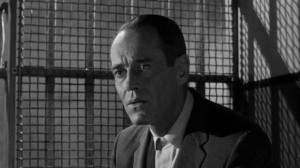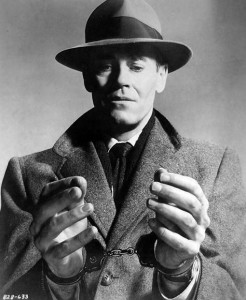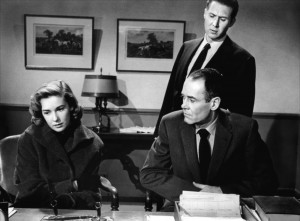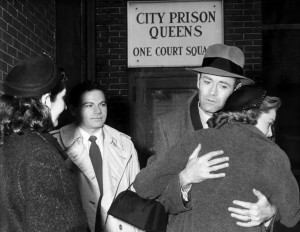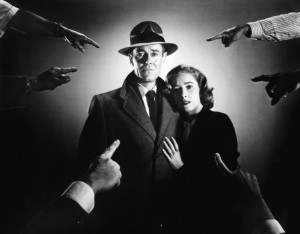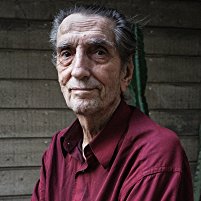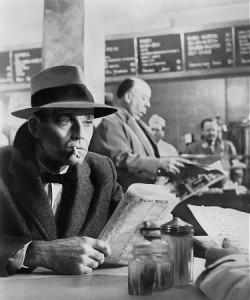The Wrong Man ***** (1956, Henry Fonda, Vera Miles, Anthony Quayle) – Classic Movie Review 387
Roman Catholic to its very soul, Alfred Hitchcock’s 1956 true-life near docudrama is a devastating portrait of a guiltless victim and his martyrdom. It’s the story of a tormented, Christ-like figure. This time, it’s not to be called a thriller at all.
Looking like a rabbit in headlights throughout, Henry Fonda gives one of his most astounding, tormented performances as a financially struggling New York string bass-player musician, Christopher Emmanuel (‘Manny’) Ballestrero. He is wrongly accused of murder when he is picked out in an identification parade as the armed robber who held up an insurance office.
Hitchcock’s film is an astonishing, spare and sombre masterpiece. He directs in inspired fashion. Fonda is a revelation as the bewildered, helpless accused man – he is a Catholic and God must have forsaken him or perhaps is just trying and testing him. The director’s protégé Vera Miles is also a revelation as Manny’s despairing wife Rose, going slowly mad under the strain.
The Wrong Man may be extraordinarily grim and depressing, especially for a Hitchcock movie which you normally expect to be playful, however dark. But, nevertheless, it is awesome all round, with outstanding work in every department. It is particularly notable for its lean and rigorous screenplay by Maxwell Anderson and Angus MacPhail, the nakedly stark black and white cinematography by Robert Burks and the moody, underplayed Bernard Herrmann score.
It is based on the book The True Story of Christopher Emmanuel Ballestrero by Maxwell Anderson. True story it may be but Hitchcock is aiming and succeeding at the highest level of a brave art-movie attempt to circumvent or overcome the limits of the mere entertainment thriller. But of course Hitchcock still ensures it has its fair share of compellingly imaginative screen moments typical of him.
That is particularly seen in the chilling arrest sequence of the innocent man played by Fonda, a scene that reflects Hitch’s often-stated fear of being seized by the police that started when he was a boy. No doubt it was this scene that attracted Hitchcock to the project in the first place.
It is a great shame that the public, no doubt put off by the grim tone and subject matter, didn’t really like it, which was a bitter blow to Hitchcock. But, as ever, he regrouped, and came back in 1958 with one of his finest as well as (eventually) most popular movies, Vertigo.
Also in the cast are Harold J Stone.Esther Minciotti, Nehemiah Persoff, Charles Cooper, Richard Robbins, Peggy Webber, Laurinda Barrett, Norma Connolly, Doreen Lang, Frances Reid, Lola D’Annunzio, Robert Essen, Dayton Lummis, John Vivyan, Will Hare, Werner Klemperer, Mel Dowd, Anna Karen, and Tuesday Weld.
Harry Dean Stanton has an uncredited role as a Department of Corrections Employee. The much loved star character actor died on 15 September 2017, aged 91. His many career highlights include Alien, Repo Man and Paris, Texas.
It runs 105 minutes, is released by Warner, is written by Maxwell Anderson and Angus MacPhail, is shot in black and white by Robert Burks, is produced by Herbert Coleman, is scored by Bernard Herrmann, and is designed by Paul Sylbert and William L Kuehl.
© Derek Winnert 2013 Classic Movie Review 387
Check out more reviews on http://derekwinnert.com/


